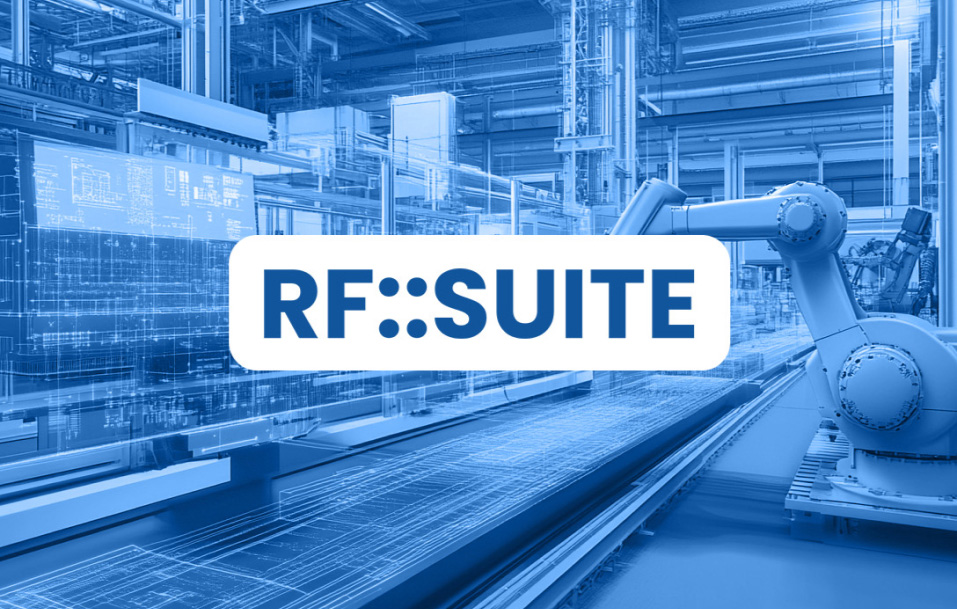Home > Plattform > Produkte > Main Modules
Das Fundament der RF::Suite – leistungsstarke Basislösungen für Ihre Produktion in den Bereichen virtuelle Inbetriebnahme und Systemoptimierung.


Die RF::SUITE bietet ein umfassendes Produktportfolio zur Revolutionierung der Anlagen-Simulation und virtuellen Produktionsmodellierung. Durch die Kombination aus fortschrittlichen Simulationsfunktionen, Echtzeit-Datenintegration und nahtloser Anbindung an reale Systeme ermöglicht die RF::Suite eine frühzeitige Validierung und Optimierung von Produktionsprozessen – noch vor der realen Umsetzung.
Key Features:
Virtuelle Inbetriebnahme: Simulieren und testen Sie Produktionsabläufe in einer risikofreien virtuellen Umgebung, um eine reibungslose Systemintegration sicherzustellen.
Digital Twin Integration: Verbessern Sie Ihre Entscheidungsfindung durch präzise digitale Abbilder Ihrer Produktionssysteme.
Echtzeit-Datensynchronisation: Verbinden Sie physische und virtuelle Systeme für präzise Simulationen und Systemvalidierung.
Anpassbare Werkzeuge: Passen Sie Arbeitsabläufe und Benutzeroberflächen gezielt an die spezifischen Anforderungen Ihrer Branche und Prozesse an.
Durch Risikominimierung, verkürzte Inbetriebnahmezeiten und gesteigerte Gesamteffizienz verschafft die RF::Suite Unternehmen entscheidende Wettbewerbsvorteile und stärkt deren operative Resilienz.

Die RF::SUITE bietet ein umfassendes Produktportfolio zur Revolutionierung der Anlagen-Simulation und virtuellen Produktionsmodellierung. Durch die Kombination aus fortschrittlichen Simulationsfunktionen, Echtzeit-Datenintegration und nahtloser Anbindung an reale Systeme ermöglicht die RF::Suite eine frühzeitige Validierung und Optimierung von Produktionsprozessen – noch vor der realen Umsetzung.
Key Features:
Virtuelle Inbetriebnahme: Simulieren und testen Sie Produktionsabläufe in einer risikofreien virtuellen Umgebung, um eine reibungslose Systemintegration sicherzustellen.
Digital Twin Integration: Verbessern Sie Ihre Entscheidungsfindung durch präzise digitale Abbilder Ihrer Produktionssysteme.
Echtzeit-Datensynchronisation: Verbinden Sie physische und virtuelle Systeme für präzise Simulationen und Systemvalidierung.
Anpassbare Werkzeuge: Passen Sie Arbeitsabläufe und Benutzeroberflächen gezielt an die spezifischen Anforderungen Ihrer Branche und Prozesse an.
Durch Risikominimierung, verkürzte Inbetriebnahmezeiten und gesteigerte Gesamteffizienz verschafft die RF::Suite Unternehmen entscheidende Wettbewerbsvorteile und stärkt deren operative Resilienz.

Die RF::SUITE bietet ein umfassendes Produktportfolio zur Revolutionierung der Anlagen-Simulation und virtuellen Produktionsmodellierung. Durch die Kombination aus fortschrittlichen Simulationsfunktionen, Echtzeit-Datenintegration und nahtloser Anbindung an reale Systeme ermöglicht die RF::Suite eine frühzeitige Validierung und Optimierung von Produktionsprozessen – noch vor der realen Umsetzung.
Key Features:
Virtuelle Inbetriebnahme: Simulieren und testen Sie Produktionsabläufe in einer risikofreien virtuellen Umgebung, um eine reibungslose Systemintegration sicherzustellen.
Digital Twin Integration: Verbessern Sie Ihre Entscheidungsfindung durch präzise digitale Abbilder Ihrer Produktionssysteme.
Echtzeit-Datensynchronisation: Verbinden Sie physische und virtuelle Systeme für präzise Simulationen und Systemvalidierung.
Anpassbare Werkzeuge: Passen Sie Arbeitsabläufe und Benutzeroberflächen gezielt an die spezifischen Anforderungen Ihrer Branche und Prozesse an.
Durch Risikominimierung, verkürzte Inbetriebnahmezeiten und gesteigerte Gesamteffizienz verschafft die RF::Suite Unternehmen entscheidende Wettbewerbsvorteile und stärkt deren operative Resilienz.
Vorteile der Haupttools
Virtuelle Inbetriebnahme
Erstellen Sie ein virtuelles Produktionsmodell mit fortschrittlichen Simulationswerkzeugen, um Arbeitsabläufe zu optimieren und kostspielige Fehler vor der Umsetzung zu vermeiden.
Monitoring
Überwachen Sie Ihre laufenden Produktionsprozesse in Echtzeit, um potenzielle Probleme frühzeitig zu erkennen und zu beheben, bevor sie den Betrieb stören.
Optimierung
Erkennen Sie Ineffizienzen und optimieren Sie Produktionsabläufe, um die Effizienz zu steigern, Kosten zu senken und die Gesamtproduktivität zu verbessern.
Ausbildung
Revolutionieren Sie das Lernen Ihrer Belegschaft, indem Sie Mitarbeitenden ermöglichen, komplexe Maschinen und Szenarien sicher zu beherrschen – durch immersive, risikofreie Simulationen, die die Kompetenzentwicklung beschleunigen und die operative Leistungsfähigkeit steigern.
Kernkomponenten der RF::Suite – mit fortschrittlichen Funktionen für Simulation, Optimierung und die Integration digitaler Zwillinge in Fertigungsprozesse.
Simuliert Produktionssysteme in einer 3D-Virtual-Environment und liefert detaillierte Einblicke in Systemleistung, Optimierungspotenziale und Betriebseffizienz.
Modelliert, simuliert und testet Peripheriekomponenten in der virtuellen Inbetriebnahme – mit wiederverwendbaren Programmbausteinen für mehr Flexibilität und Effizienz.
Bietet fortschrittliche Robotersimulation zur Prüfung und Optimierung von Roboterprogrammen – für fehlerfreie Inbetriebnahme und effiziente Abläufe.
Analysiert Produktionsdaten aus virtuellen und realen Systemen, um Engpässe zu erkennen, die Leistung zu optimieren und die Produktionseffizienz zu steigern.
Automatisiert die 3D-Vorrichtungsplanung mit bearbeitbaren Modellen – für maximale Flexibilität der Konstrukteure und optimierte Produktionsabläufe.
Simuliert Profinet-Geräte für die virtuelle Inbetriebnahme und ermöglicht nahtloses Testen mehrerer SPS-Steuerungen in einer einzigen Umgebung.
Stärken Sie die Qualifizierung Ihrer Mitarbeitenden mit virtuellem Training für praxisnahe Kompetenzen.
SPS-Connectoren
China,
Shanghai
Deutschland,
Weingarten
Bosnien,
Tuzla
Indien,
Bangalore
Montenegro,
Podgorica

China, Shanghai

Deutschland, Weingarten

Bosnien, Tuzla
Indien, Bangalore

Montenegro, Podgorica
Wir verwenden Cookies und andere Tracking-Technologien, um Ihr Nutzungserlebnis auf unserer Website zu verbessern, personalisierte Inhalte und gezielte Werbung anzuzeigen, den Website-Traffic zu analysieren und zu verstehen, woher unsere Besucher kommen.